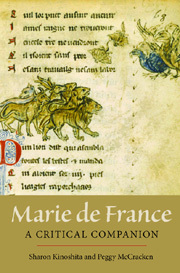Book contents
- Frontmatter
- Contents
- Preface
- Note on Editions
- 1 Introduction: the World of Marie de France
- 2 Communication, Transmission, and Interpretation: Literary History
- 3 Courtly Love and Feudal Society: Historical Context
- 4 Movement and Mobility: Plot
- 5 Bodies and Embodiment: Characters
- 6 Repetition and the Art of Variation: Narrative Techniques
- 7 Posterity: The Afterlives of Marie's Works
- Further Reading
- Index
- Already Published
Preface
Published online by Cambridge University Press: 12 September 2012
- Frontmatter
- Contents
- Preface
- Note on Editions
- 1 Introduction: the World of Marie de France
- 2 Communication, Transmission, and Interpretation: Literary History
- 3 Courtly Love and Feudal Society: Historical Context
- 4 Movement and Mobility: Plot
- 5 Bodies and Embodiment: Characters
- 6 Repetition and the Art of Variation: Narrative Techniques
- 7 Posterity: The Afterlives of Marie's Works
- Further Reading
- Index
- Already Published
Summary
This Companion is intended for all those interested in the works of Marie de France – students, teachers, and general readers as well as scholars. Our goal has been to provide a multifaceted overview of this influential author, combining a reconsideration of the Lais with an introduction to her lesser-known works, the Ysopë (Fables) and the Espurgatoire seint Patriz, and some attention to the more controversially attributed Vie seinte Audree. To do this, we set out to rethink standard questions such as those of origins, context, plot, character, structure, and influence through categories (such as authorship and translation) that seemed to us central to the consideration of medieval literature in general, as well as those (such as space/movement and embodiment) that have special resonance for the texts of Marie de France in particular. We hope in this way to have offered an integrated view that takes account both of the unity of Marie's oeuvre and of the distinctiveness of the individual texts.
The critical literature on Marie de France is vast, and our understanding of her texts is informed and shaped by our own reading of the rich, learnèd, and thoughtful work of our colleagues and predecessors. The studies mentioned in our text, notes, and “Further Reading” guide are those that have especially influenced our thinking here or that provide particularly focused discussions of the topics under consideration. Glyn S. Burgess's annotated bibliographies (listed in the first section of the “Further Reading” guide) remain an indispensable point of departure for anyone interested in Marie scholarship.
- Type
- Chapter
- Information
- Marie de FranceA Critical Companion, pp. vii - viiiPublisher: Boydell & BrewerPrint publication year: 2012

